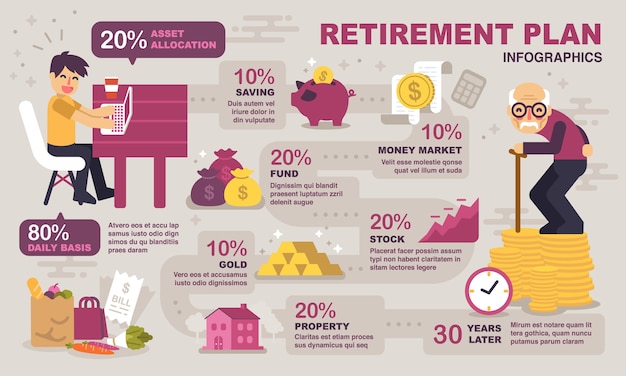Decode US Retirement Changes: Maximize Your 401(k) by 2025

Anúncios
Decoding the Latest Changes to US Retirement Account Contribution Limits: Maximize Your 401(k) Before December 31, 2025 involves understanding updated contribution limits for 401(k)s and other retirement accounts, strategic planning to optimize savings within new regulations, and timely adjustments to financial strategies for maximizing benefits by the specified deadline.
Are you ready to take control of your retirement savings and make the most of the opportunities available? Decoding the Latest Changes to US Retirement Account Contribution Limits: Maximize Your 401(k) Before December 31, 2025 is crucial for anyone looking to secure their financial future.
Anúncios
Understanding the 2024-2025 Retirement Account Landscape
Navigating the world of retirement accounts can feel like deciphering a complex code. Each year brings updates and adjustments to contribution limits and regulations, making it essential to stay informed. For 2024 and leading up to December 31, 2025, several key changes impact how Americans can save for retirement.
Understanding these changes isn’t just about compliance; it’s about strategically maximizing your savings to achieve your retirement goals. Let’s break down the current landscape to help you make informed decisions.
Anúncios
Key Contribution Limit Updates
The IRS sets contribution limits annually to reflect inflation and other economic factors. Keeping up with these figures is vital for optimizing your retirement contributions and avoiding penalties.
- 401(k) Contribution Limits: For 2024, the employee contribution limit for 401(k) plans is $23,000, with a catch-up contribution of an additional $7,500 for those age 50 and over.
- IRA Contribution Limits: Traditional and Roth IRAs have a contribution limit of $7,000 for 2024, with a $1,000 catch-up contribution for those 50 and older.
- SEP IRA Limits: For self-employed individuals, SEP IRA contributions are limited to 20% of net self-employment income, up to a maximum of $66,000 for 2024.
These limits are crucial to understand as you plan your contributions. Exceeding these limits can lead to tax penalties, so staying informed is key.

Employer Matching and its Impact
One of the most significant benefits of participating in a 401(k) plan is employer matching. Many employers offer to match a percentage of employee contributions, effectively boosting your retirement savings.
Understanding your employer’s matching policy is crucial. Make sure you contribute enough to take full advantage of the match, as this is essentially free money towards your retirement.
In conclusion, the 2024-2025 retirement account landscape offers significant opportunities for those who stay informed and plan strategically. Understanding the latest contribution limits and maximizing employer matching can significantly impact your retirement savings.
Strategic Planning for Maximum 401(k) Contributions
To get the most out of your 401(k) and maximize your retirement savings before the end of 2025, strategic planning is essential. This involves evaluating your current financial situation, understanding your risk tolerance, and setting clear retirement goals.
With a well-thought-out strategy, you can optimize your contributions and potentially accelerate your journey to a comfortable retirement.
Assessing Your Financial Situation
Before making any changes to your 401(k) contributions, it’s important to assess your overall financial health. This involves looking at your income, expenses, debts, and other investments.
Consider the following steps:
- Calculate Your Income: Determine your net income after taxes and other deductions.
- Track Your Expenses: Understand where your money is going each month by tracking your expenses.
- Evaluate Your Debts: Assess your outstanding debts, including credit card debt, loans, and mortgages.
Maximizing Contributions Within Your Budget
Once you have a clear understanding of your financial situation, you can start planning how to maximize your 401(k) contributions without straining your budget. Finding ways to free up extra cash can make a significant difference.
Here are some strategies to consider:
- Reduce Discretionary Spending: Identify areas where you can cut back on non-essential expenses, such as dining out, entertainment, and subscriptions.
- Automate Your Savings: Set up automatic transfers from your checking account to your 401(k) each pay period. This ensures that you consistently contribute to your retirement savings.
- Adjust Your Tax Withholding: If you typically receive a large tax refund, consider adjusting your tax withholding to have more money each month to contribute to your 401(k).
Adjusting Your Investment Strategy
Regularly reviewing and adjusting your investment strategy is crucial for optimizing your returns and managing risk. Your investment strategy should align with your risk tolerance, time horizon, and retirement goals.
Consider the following:
- Diversify Your Investments: Spreading your investments across different asset classes, such as stocks, bonds, and real estate, can help reduce risk.
- Rebalance Your Portfolio: Over time, your asset allocation may drift away from your target allocation due to market fluctuations. Rebalancing involves selling some assets and buying others to bring your portfolio back into alignment.
- Consider Professional Advice: If you’re unsure how to adjust your investment strategy, consider seeking the advice of a financial advisor.
Strategic planning is the cornerstone of maximizing your 401(k) contributions. By assessing your financial situation, finding ways to contribute more within your budget, and adjusting your investment strategy, you can set yourself up for a secure and comfortable retirement.
Understanding the Catch-Up Contribution Provision
One of the most significant benefits available to older workers is the catch-up contribution provision. This allows individuals age 50 and over to contribute more to their retirement accounts than the standard limits.
Understanding and utilizing this provision can significantly boost your retirement savings as you approach retirement age.
Eligibility for Catch-Up Contributions
To be eligible for catch-up contributions, you must be age 50 or older by the end of the calendar year. This applies to both 401(k) and IRA accounts.
For 2024, the catch-up contribution limit for 401(k) plans is an additional $7,500, while for IRAs, it’s an additional $1,000. These amounts are in addition to the standard contribution limits.
Maximizing Catch-Up Contributions
If you’re eligible for catch-up contributions, it’s essential to maximize these contributions to the extent possible. This can significantly accelerate your retirement savings.
Here are some strategies to consider:
- Adjust Your Budget: Look for ways to free up additional cash in your budget to contribute the maximum amount to your retirement accounts.
- Automate Your Catch-Up Contributions: Set up automatic transfers from your checking account to your retirement accounts to ensure that you consistently contribute the maximum amount.
- Take Advantage of Employer Matching: If your employer offers matching contributions, make sure you contribute enough to take full advantage of the match.
Tax Implications of Catch-Up Contributions
Catch-up contributions have the same tax implications as regular contributions to retirement accounts. Contributions to traditional 401(k) and IRA accounts are typically tax-deductible, while contributions to Roth 401(k) and Roth IRA accounts are not, but qualified withdrawals in retirement are tax-free.

Understanding the tax implications of your contributions can help you make informed decisions about which type of retirement account is best for you.
In summary, the catch-up contribution provision is a valuable tool for older workers looking to boost their retirement savings. By understanding the eligibility requirements, maximizing your contributions, and considering the tax implications, you can take full advantage of this benefit.
Navigating Roth vs. Traditional 401(k) Options
When it comes to saving for retirement through a 401(k), you typically have two main options: a Roth 401(k) and a traditional 401(k). Understanding the differences between these options is crucial for making the best choice for your individual financial situation.
The primary distinction lies in how your contributions and withdrawals are taxed. Let’s delve into the details to help you navigate these options.
Key Differences Between Roth and Traditional 401(k)s
The main difference between Roth and traditional 401(k)s is the timing of tax payments. With a traditional 401(k), contributions are made pre-tax, meaning they reduce your taxable income in the year you make them. However, withdrawals in retirement are taxed as ordinary income.
In contrast, with a Roth 401(k), contributions are made after-tax, meaning they don’t reduce your taxable income in the year you make them. However, qualified withdrawals in retirement are tax-free.
Factors to Consider When Choosing
Choosing between a Roth and traditional 401(k) depends on several factors, including your current and expected future tax bracket. If you expect to be in a higher tax bracket in retirement, a Roth 401(k) may be the better choice.
Other factors to consider include your age, time horizon, and risk tolerance. If you’re younger and have a longer time horizon, a Roth 401(k) may be more appealing due to the potential for tax-free growth over many years.
Making the Right Choice for Your Situation
Ultimately, the decision between a Roth and traditional 401(k) is a personal one that should be based on your individual financial circumstances. Consider consulting with a financial advisor to help you evaluate your options and make the best choice for your situation.
- Consider Your Tax Bracket: If you expect to be in a higher tax bracket in retirement, a Roth 401(k) may be the better choice.
- Consider Your Time Horizon: If you have a longer time horizon, a Roth 401(k) may be more appealing due to the potential for tax-free growth over many years.
- Consider Your Risk Tolerance: If you’re comfortable paying taxes now in exchange for tax-free withdrawals in retirement, a Roth 401(k) may be a good fit.
Navigating the Roth vs. traditional 401(k) options requires careful consideration of your individual financial situation. By understanding the key differences and factors to consider, you can make an informed decision that aligns with your retirement goals.
Reviewing Your Beneficiaries and Estate Planning
While maximizing your 401(k) contributions is crucial, it’s equally important to ensure that your retirement assets are protected and will be distributed according to your wishes. Reviewing your beneficiaries and incorporating estate planning into your retirement strategy are essential steps.
Proper estate planning can provide peace of mind, knowing that your loved ones will be taken care of and your assets will be distributed efficiently.
Importance of Naming Beneficiaries
Naming beneficiaries for your retirement accounts is crucial for ensuring that your assets are distributed according to your wishes. Without a designated beneficiary, your retirement assets may be subject to probate, which can be a lengthy and costly process.
It’s important to review your beneficiaries regularly, especially after major life events such as marriage, divorce, or the birth of a child. Make sure your beneficiaries are up-to-date and accurately reflect your current wishes.
Incorporating Estate Planning into Your Retirement Strategy
Estate planning involves creating a comprehensive plan for managing and distributing your assets after your death. This can include creating a will, establishing trusts, and minimizing estate taxes.
Incorporating estate planning into your retirement strategy can help ensure that your assets are protected and will be distributed according to your wishes. Consider consulting with an estate planning attorney to help you create a plan that meets your specific needs and goals.
- Create a Will: A will is a legal document that specifies how you want your assets to be distributed after your death.
- Establish Trusts: Trusts can be used to manage and protect your assets, as well as to provide for your loved ones.
- Minimize Estate Taxes: Estate taxes can significantly reduce the value of your estate. Consider strategies to minimize estate taxes, such as gifting assets to loved ones during your lifetime.
Regularly Updating Your Plan
Estate planning is not a one-time event. It’s important to regularly review and update your plan to reflect changes in your life, such as marriage, divorce, or the birth of a child. Laws and regulations can also change, so it’s important to stay informed and make any necessary adjustments to your plan.
Reviewing your beneficiaries and incorporating estate planning into your retirement strategy are essential steps for protecting your assets and ensuring that your wishes are carried out. Consider consulting with a financial advisor and an estate planning attorney to create a comprehensive plan that meets your specific needs and goals.
Seeking Professional Financial Advice
Navigating the complexities of retirement planning can be overwhelming, especially with constantly changing contribution limits and regulations. Seeking professional financial advice can provide clarity and help you make informed decisions that align with your retirement goals.
A qualified financial advisor can offer personalized guidance and support, helping you optimize your retirement savings and achieve financial security.
Benefits of Working with a Financial Advisor
Working with a financial advisor offers numerous benefits, including:
- Personalized Guidance: A financial advisor can provide personalized guidance based on your individual financial situation, goals, and risk tolerance.
- Expert Knowledge: Financial advisors have expert knowledge of retirement planning strategies, investment options, and tax implications.
- Objective Advice: Financial advisors can provide objective advice, helping you make informed decisions without emotional biases.
How to Choose the Right Advisor
Choosing the right financial advisor is crucial for ensuring that you receive competent and trustworthy advice. Consider the following factors:
- Credentials and Experience: Look for advisors who have relevant credentials, such as Certified Financial Planner (CFP) or Chartered Financial Analyst (CFA), and who have experience working with clients in similar situations.
- Fee Structure: Understand how the advisor is compensated. Some advisors charge a percentage of assets under management, while others charge an hourly fee or a commission.
- Client Reviews and References: Check online reviews and ask for references from other clients.
Questions to Ask a Potential Advisor
Before hiring a financial advisor, it’s important to ask them questions to assess their qualifications and approach to retirement planning. Consider asking the following:
- What is your experience in retirement planning?
- What is your investment philosophy?
- How do you handle conflicts of interest?
Seeking professional financial advice can be a valuable investment in your retirement future. By working with a qualified advisor, you can gain clarity, make informed decisions, and optimize your retirement savings to achieve your financial goals.
| Key Point | Brief Description |
|---|---|
| 💰 Contribution Limits | Understand annual limits for 401(k)s & IRAs to maximize savings effectively. |
| 👵 Catch-Up Contributions | If 50+, leverage extra contributions to boost retirement accounts. |
| 📈 Investment Strategy | Adjust portfolio for optimal growth aligned with your risk tolerance. |
| 🤝 Professional Advice | Consider a financial advisor for personalized retirement planning. |
Frequently Asked Questions
▼
For 2024, the employee contribution limit for 401(k) plans is $23,000. Those age 50 and over can contribute an additional $7,500 as a catch-up contribution, bringing their total possible contribution to $30,500.
▼
For 2024, the contribution limit for both Traditional and Roth IRAs is $7,000. Individuals aged 50 and over can contribute an additional $1,000 as a catch-up contribution, making their total potential contribution $8,000.
▼
Many employers offer to match a percentage of your 401(k) contributions, essentially giving you free money toward retirement. Always contribute enough to take full advantage of your employer’s match to maximize your savings.
▼
If you expect to be in a higher tax bracket in retirement, a Roth 401(k) might be better, as withdrawals are tax-free. If you’re in a higher tax bracket now, a Traditional 401(k) can reduce your current taxable income.
▼
Reviewing beneficiaries ensures that your retirement assets are distributed according to your wishes. Update them after major life events like marriage, divorce, or the birth of a child to accurately reflect your intentions.
Conclusion
Understanding and acting on the latest changes to US retirement account contribution limits, particularly for 401(k)s, is essential for maximizing your savings before December 31, 2025. Strategic planning, leveraging catch-up contributions, and seeking professional advice can help you secure a more comfortable financial future. Stay informed and take proactive steps to optimize your retirement strategy.





